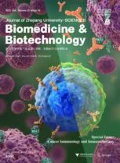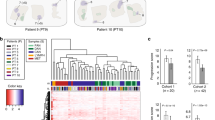Abstract
Objective
To investigate molecular alterations associating with prostate carcinoma progression and potentially provide information toward more accurate prognosis/diagnosis.
Methods
A set of laser captured microdissected (LCM) specimens from 300 prostate cancer (PCa) patients undergoing radical prostatectomy (RP) were defined. Ten patients representing “aggressive” PCa, and 10 representing “non-aggressive” PCa were selected based on prostate-specific antigen (PSA) recurrence, Gleason score, pathological stage and tumor cell differentiation, with matched patient age and race between the two groups. Normal and neoplastic prostate epithelial cells were collected with LCM from frozen tissue slides obtained from the RP specimens. The expressions of a panel of genes, including NPY, PTEN, AR, AMACR, DD3, and GSTP1, were measured by quantitative real-time RT-PCR (TaqMan), and correlation was analyzed with clinicopathological features.
Results
The expressions of AMACR and DD3 were consistently up-regulated in cancer cells compared to benign prostate epithelial cells in all PCa patients, whereas GSTP1 expression was down regulated in each patient. NPY, PTEN and AR exhibited a striking difference in their expression patterns between aggressive and non-aggressive PCas (P=0.0203, 0.0284, and 0.0378, respectively, Wilcoxon rank sum test). The lower expression of NPY showed association with “aggressive” PCas based on a larger PCa patient cohort analysis (P=0.0037, univariate generalized linear model (GLM) analysis).
Conclusion
Despite widely noted heterogeneous nature of PCa, gene expression alterations of AMACR, DD3, and GSTP1 in LCM-derived PCa epithelial cells suggest for common underlying mechanisms in the initiation of PCa. Lower NPY expression level is significantly associated with more aggressive clinical behavior of PCa; PTEN and AR may have potential in defining PCa with aggressive clinical behavior. Studies along these lines have potential to define PCa-associated gene expression alterations and likely co-regulation of genes/pathways critical in the biology of PCa onset/progression.
Similar content being viewed by others
References
Bialkowska-Hobrzanska, H., Driman, D.K., Fletcher, R., Harry, V., Razvi, H., 2006. Expression of human telomerase reverse transcriptase, survivin, DD3 and PCGEM1 messenger RNA in archival prostate carcinoma tissue. Can. J. Urol., 13(1):1967–1974.
Bjellerup, P., Theodorsson, E., Jornvall, H., Kogner, P., 2000. Limited neuropeptide Y precursor processing in unfavourable metastatic neuroblastoma tumours. Br. J. Cancer, 83(2):171–176. [doi:10.1054/bjoc.2000.1234]
Chen, C.D., Welsbie, D.S., Tran, C., Baek, S.H., Chen, R., Vessella, R., Rosenfeld, M.G., Sawyers, C.L., 2004. Molecular determinants of resistance to antiandrogen therapy. Nature Medicine, 10(1):33–39. [doi:10.1038/nm972]
D’Amico, A.V., 2001. Combined-modality staging for localized adenocarcinoma of the prostate. Oncology (Huntington), 15(8):1049–1059.
Jemal, A., Siegel, R., Ward, E., Murray, T., Xu, J., Thun, M.J., 2007. Cancer statistics, 2007. C. A. Cancer J. Clin., 57(1):43–66.
Knerr, I., Schuster, S., Nomikos, P., Buchfelder, M., Sotsch, J., Schoof, E., Fahlbusch, R., Rascher, W., 2001. Gene expression of adrenomedullin, leptin, their receptors and neuropeptide Y in hormone-secreting and non-functioning pituitary adenomas, meningiomas and malignant intracranial tumors in humans. Neuropathol. Appl. Neurobiol., 27(3):215–222. [doi:10.1046/j.0305-1846.2001.00324.x]
Kumar-Sinha, C., Chinnaiyan, A.M., 2003. Molecular markers to identify patients at risk for recurrence after primary treatment for prostate cancer. Urology, 62(Suppl. 6B):19–35. [doi:10.1016/j.urology.2003.10.007]
Mack, D., Hacker, G.W., Hauser-Kronberger, C., Frick, J., Dietze, O., 1997. Vasoactive intestinal polypeptide (VIP) and neuropeptide tyrosine (NPY) in prostate carcinoma. Eur. J. Cancer, 33(2):317–318. [doi:10.1016/S0959-8049(96)00402-9]
Meiers, I., Shanks, J.H., Bostwick, D.G., 2007. Glutathione S-transferase pi (GSTP1) hypermethylation in prostate cancer: review 2007. Pathology, 39(3):299–304. [doi:10.1080/00313020701329906]
Montironi, R., Scarpelli, M., López Beltran, A., 2004. Carcinoma of the prostate: inherited susceptibility, somatic gene defects and androgen receptors. Virchows Arch., 444(6):503–508. [doi:10.1007/s00428-004-0996-2]
Murphy, A.J., Hughes, C.A., Lannigan, G., Sheils, O., O’Leary, J., Loftus, B., 2007. Heterogeneous expression of alpha-methylacyl-CoA racemase in prostatic cancer correlates with Gleason score. Histopathology, 50(2):243–251. [doi:10.1111/j.1365-2559.2007.02572.x]
Pourmand, G., Ziaee, A.A., Abedi, A.R., Mehrsai, A., Alavi, H.A., Ahmadi, A., Saadati, H.R., 2007. Role of PTEN gene in progression of prostate cancer. Urol. J., 4(2):95–100.
Rasiah, K.K., Kench, J.G., Gardiner-Garden, M., Biankin, A.V., Golovsky, D., Brenner, P.C., 2006. Aberrant neuropeptide Y and macrophage inhibitory cytokine-1 expression are early events in prostate cancer development and are associated with poor prognosis. Cancer Epidemiol. Biomarkers Prev., 15(4):711–716. [doi:10.1158/1055-9965.EPI-05-0752]
Reubi, J.C., Gugger, M., Waser, B., Schaer, J.C., 2001. Y1-mediated effect of NPY in cancer: breast carcinomas as targets. Cancer Res., 61(11):4636–4641.
Ruscica, M., Dozio, E., Boghossian, S., Bovo, G., Martos Riaño, V., Motta, M., Magni, P., 2006. Activation of the Y1 receptor by neuropeptide Y regulates the growth of prostate cancer cells. Endocrinology, 147(3):1466–1473. [doi:10.1210/en.2005-0925]
Ruscica, M., Dozio, E., Motta, M., Magni, P., 2007. Modulatory actions of neuropeptide Y on prostate cancer growth: role of MAP kinase/ERK 1/2 activation. Adv. Exp. Med. Biol., 604(1):96–100.
Shaheduzzaman, S., Gao, C.L., Wang, Z., Furusato, B., Petrovics, G., Srikantan, V., Ravindranath, L., Nau, M.E., Chen, Y.D., Chen, Y.M., et al., 2006. Prostate Epithelial Cell Specific Gene Expression Signatures Define Prostate Cancer Patients at High or Moderate Risk of Disease Progression. Presented at 97th AACR Annual Meeting. Washington DC, USA.
Silva, A.P., Cavadas, C., Grouzmann, E., 2002. Neuropeptide Y and its receptors as potential therapeutic drug targets. Clinica Chimica Acta, 326(1–2):3–25. [doi:10.1016/S0009-8981(02)00301-7]
Singh, D., Febbo, P.G., Ross, K., Jackson, D.G., Manola, J., Ladd, C., Tamayo, P., Renshaw, A.A., D’Amico, A.V., Ritchie, J.P., et al., 2002. Gene expression correlates of clinical prostate cancer behavior. Cancer Cell, 1(2):203–209. [doi:10.1016/S1535-6108(02)00030-2]
Yoshimoto, M., Cunha, I.W., Coudry, R.A., Fonseca, F.P., Torres, C.H., Soares, F.A., Squire, J.A., 2007. FISH analysis of 107 prostate cancers shows that PTEN genomic deletion is associated with poor clinical outcome. Br. J. Cancer, 97(5):678–685. [doi:10.1038/sj.bjc.6603924]
Author information
Authors and Affiliations
Corresponding authors
Additional information
Project supported by the Center for Prostate Disease Research, and the Henry M. Jackson Foundation for the Advancement of Military Medicine, Rockville, MD, USA
Rights and permissions
About this article
Cite this article
Liu, Aj., Furusato, B., Ravindranath, L. et al. Quantitative analysis of a panel of gene expression in prostate cancer—with emphasis on NPY expression analysis. J. Zhejiang Univ. - Sci. B 8, 853–859 (2007). https://doi.org/10.1631/jzus.2007.B0853
Received:
Accepted:
Issue Date:
DOI: https://doi.org/10.1631/jzus.2007.B0853
Key words
- Prostate cancer
- NPY expression
- Quantitative real-time reverse-transcript polymerase chain reaction (RT-PCR)




